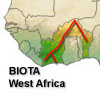 



Weather data
A large number of automatic weather stations has been implemented in the frame of the BIOTA AFRICA project by the Namibian National Botanical Research Institute (NBRI) and the Group "Biodiversity, Evolution and Ecology" (BEE) of the University of Hamburg. The website offers hourly updates of data and graphs of a large number of weather parameters.

|
 BIOTA West Africa - Workpackage - CT2-T1-WP2c
BIOTA West Africa - Workpackage - CT2-T1-WP2c
Core Topic (CT) |
Land use changes: agriculture and restoration |
Topic (T) |
Land use change related to cash crops |
Title |
 Socio-economic causes and consequences of cotton and cacao cultivation - The socio-economics of cacao production in Côte d'Ivoire
Socio-economic causes and consequences of cotton and cacao cultivation - The socio-economics of cacao production in Côte d'Ivoire
|
Project leader(s) |
Prof. Dr. N’Guessan Kouakou
Prof. Dr. Stefan Porembski & Dr. Dethardt Goetze
|
Project description |
The study region extending from the Lamto Reserve westwards to the village of Oumé, which is part of the so-called former “boucle du cacao”, represents a major smallholder cacao production area in Côte d’Ivoire with numerous fields of varying cultivation intensity. It is the same study area covered by WP1a. Between the mid-1960s and the early 1980s, the population structure changed due to immigration of people also intending to grow cacao.
The demographic and economic impacts of this immigration surge on socio-cultural values of local peasant families and their consequences for cacao production and cultivation practices, land use patterns, and farming system development are investigated with regard to their effects up to today. In this context, the sensitivity of the cacao production system on price signals, on (dis-)incentives from government policies, and the adoption of technical and institutional innovations are of high relevance. A major focus is also laid on changes in the roles of women and men in the peasants’ family and village life due to increased and intensified cacao cultivation compared to traditional food crops cultivation. As the surface of cultivated land has been expanding ever since, the effects of increasing vegetation degradation studied during the second BIOTA phase and in WP1a on farm revenues and costs of exploitation for peasants will be uncovered.
|
|
|






 Go to the WeatherNet
Go to the WeatherNet BIOTA West Africa - Workpackage - CT2-T1-WP2c
BIOTA West Africa - Workpackage - CT2-T1-WP2c Socio-economic causes and consequences of cotton and cacao cultivation - The socio-economics of cacao production in Côte d'Ivoire
Socio-economic causes and consequences of cotton and cacao cultivation - The socio-economics of cacao production in Côte d'Ivoire